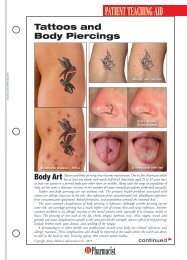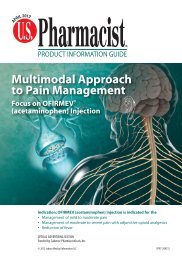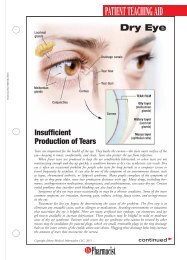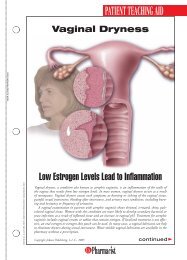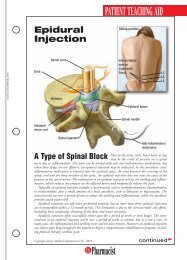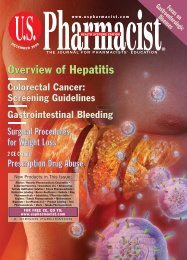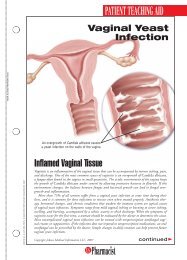View PDF Edition - U.S. Pharmacist
View PDF Edition - U.S. Pharmacist
View PDF Edition - U.S. Pharmacist
You also want an ePaper? Increase the reach of your titles
YUMPU automatically turns print PDFs into web optimized ePapers that Google loves.
NUTRITION AND CLINICAL DEPRESSIONHEALTH SYSTEMS EDITIONbrain, the omega-3 fatty acidalpha-linolenic was found tohave a major role. An importanttrend has been observed from thefindings of some recent studiesthat lowering plasma cholesterolby diet and medications mightincrease depression. Among thesignificant factors involved arethe quantity and ratio of omega-6 and omega-3 polyunsaturatedfatty acids (PUFAs) that affectserum lipids and alter the biochemicaland biophysical propertiesof cell membranes. It hasbeen hypothesized that sufficientlong-chain PUFAs, especiallyDHA, may decrease the developmentof depression. 15The glycerophospholipids inthe brain consist of a high proportionof PUFAs derived fromthe essential fatty acids, linoleicacid, and alpha-linolenic acid.The main PUFAs in the brainare DHA, derived from theomega-3 fatty acid alphalinolenicacid, arachidonic acid,and docosatetraenoic acid, bothderived from the omega-6 fattyacid and linoleic acid. Experimentalstudies have alsorevealed that diets lackingomega-3 PUFAs lead to considerabledisturbance in neuralfunction. 16Age, Depression, and CAMAnorexia in the elderly may playan important role in precipitatingdepression, either by reducingfood intake directly or inresponse to such adverse factorsas age-associated reductions insensory perception (taste andsmell), poor dentition, use ofmultiple prescription drugs, anddepression. Currently, to tacklethe problem of depression, manypeople are following the complementaryand alternative medicine(CAM) interventions. CAMtherapies are defined by theNational Center for Complementaryand Alternative Medicineas “a group of diverse medicaland health systems,practices, and products that arenot considered to be a part ofconventional medicine.” 17 Mentalhealth professionals need tobe aware that it is likely that afair number of their patientswith bipolar disorder might useCAM interventions. Some cliniciansjudge these interventionsto be attractive and safe alternativesor adjuncts to conventionalpsychotropic medications.Current research in psychoneuroimmunologyand brainbiochemistry indicates the possibilityof communication pathwaysthat can provide a clearerunderstanding of the associationbetween nutritional intake, thecentral nervous system, andimmune function, thereby influencingan individual’s psychologicalhealth status. These findingsmay lead to greater acceptance ofthe therapeutic value of dietaryintervention among health practitionersand health care providersin addressing depression andother psychological disorders. 18The Safety ofVitamin SupplementsVitamin C and the B-complexvitamins, discussed above, are allwater soluble; therefore, theycannot accumulate in the bodyor be stored for future use.Amounts above and beyond currentnutritional needs areexcreted through urine. As aresult, there is little danger ofoverdosing. Unlike water-solublevitamins, lipid-soluble vitaminsand minerals can be stored inbody tissues. For therapeuticdoses of these compounds, theadvice of a qualified nutritionconsultant is required. Do notexceed the recommended therapeuticdoses, since accumulationof certain minerals in the bodycan be dangerous. 19REFERENCES1. Shaheen Lakhan SE, Vieira KF. Nutritionaltherapies for mental disorders. Nutr J. 2008;7:2.2. National Institute of Mental Health. Depression.Bethesda, MD: US Department of Healthand Human Services; 2000 [reprinted September2002].3. Bourre JM. Effect of nutrients (in food) on thestructure and function of the nervous system:update on dietary requirements for brain, part 1:nicronutrients. J Nutr Health Aging. 2006;10:377-385.4. Massimo CM, Ferrara A, Boscati L, et al.Plasma and platelet amino acid concentrations inpatients affected by major depression and underFluvoxamine treatment. Neuropsychobiology.1998;37:124-129.5. Shaw K, Turner J, Del Mar C. Tryptophan and5-hydroxytryptophan for depression. CochraneDatabase of Systematic Reviews. 2002;1:articleCD003198.6. Rush AJ. The varied clinical presentations ofmajor depressive disorder. J Clin Psychiatry.2007;68:4-10.7. Firk C, Markus CR. Serotonin by stress interaction:a susceptibility factor for the developmentof depression? J Psychopharmacol. 2007;21:538-544.8. Ruhe HG, Mason NS, Schene AH. Mood isindirectly related to serotonin, norepinephrineand dopamine levels in humans: a meta-analysisof monoamine depletion studies. Mol Psychiatry.2007;12:331-359.9. Horrobin DF, Manku MS. Possible role ofprostaglandin E1 in the affective disorders and inalcoholism. Br Med J. 1980;280(6228):1363-1366.10. Bourre JM. Effect of nutrients (in food) onthe structure and function of the nervous system:update on dietary requirements for brain, part 1:micronutrients. J Nutr Health Aging.2006;10:377-385.11. Abou-Saleh MT, Coppen A. Folic acid andthe treatment of depression. J Psychosom Res.2006;61:285-287.12. Levenson CW. Zinc, the new antidepressant?Nutr Rev. 2006;6:39-42.13. Eby GA, Eby KL. Rapid recovery from majordepression using magnesium treatment. MedHypotheses. 2006;67:362-370.14. Benton D. Selenium intake, mood and otheraspects of psychological functioning. Nutr Neurosci.2002;5:363-374.15. Bourre JM. Dietary omega-3 fatty acids andpsychiatry: mood, behavior, stress, depression,dementia and aging. J Nutr Health Aging.2005;9:31-38.16. Sinclair AJ, Begg D, Mathai M, WeisingerRS. Omega-3 fatty acids and the brain: review ofstudies in depression. Asia Pac J Clin Nutr.2007;16:391-397.17. Roberts SB. Energy regulation and aging:recent findings and their implications. Nutr Rev.2000;58:91-97.18. Andreescu C, Mulsant BH, Emanuel JE.Complementary and alternative medicine in thetreatment of bipolar disorder: a review of the evidence.J Affect Disord. May 2, 2008 [Epub aheadof print].19. Eritsland J. Safety considerations of polyunsaturatedfatty acids. Am J Clin Nutr.2000;71:197S-201S.HS-34U.S. <strong>Pharmacist</strong> • November 2009 • www.uspharmacist.com




